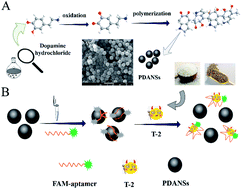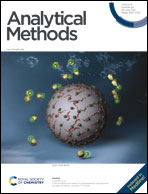A facile aptasensor based on polydopamine nanospheres for high-sensitivity sensing of T-2 toxin†
Abstract
A facile fluorescent aptasensor based on polydopamine nanospheres (PDANSs) has been proposed for the rapid and high sensitive sensing of T-2 toxin. PDANSs are dopamine-derived synthetic eumelanin polymers with excellent fluorescence quenching ability, dispersibility and biocompatibility. In the assay, 6-carboxyfluorescein (FAM)-labeled aptamers (FAM-aptamers) were adsorbed onto PDANSs via noncovalent bonding, resulting in quenching fluorescence. In the presence of T-2, the binding of T-2 to the aptamers could promote the formation of the A-form duplex hairpin structure, which was used as a sensing platform to detect T-2 on the basis of fluorescence recovery. The results showed that the aptasensor was rapid and sensitive for the detection of T-2 toxin with a linear detection range of 10–180 μg L−1 and a detection limit of 7.23 μg L−1. The performance of the proposed method was comparable with that of the liquid chromatography-mass spectrometry method (LC-MS). Thus, the aptasensor could be used for the determination of real samples. The design method proposed in this study provides a strategy for the development of PDANS-based toxin biosensors.



 Please wait while we load your content...
Please wait while we load your content...